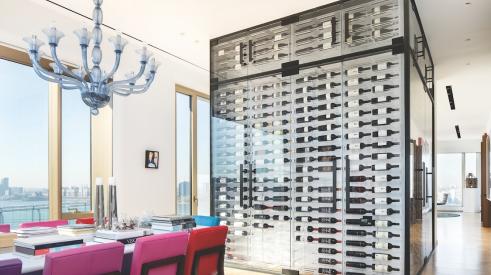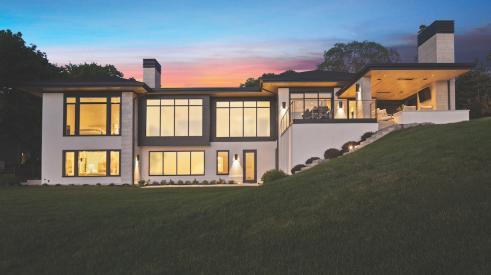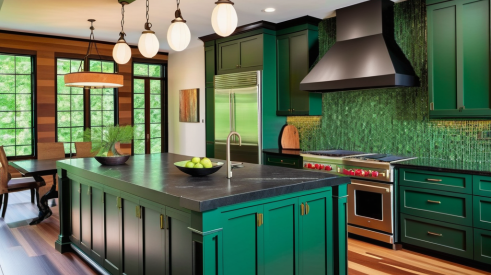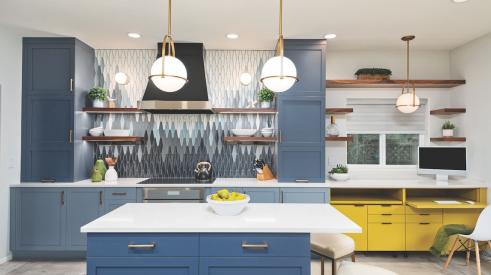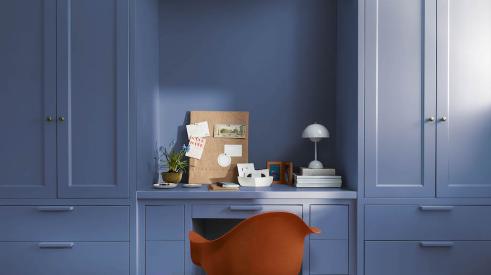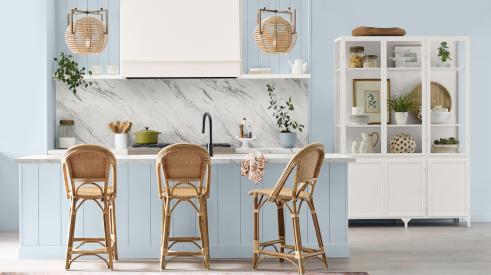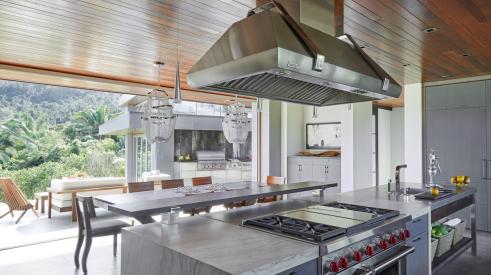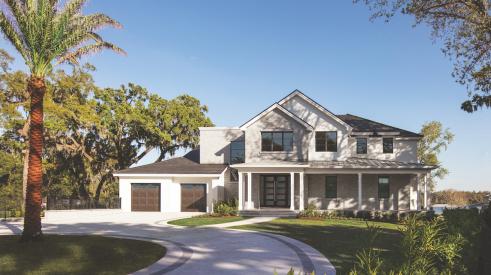|
The food at Fiorentino's outclassed the building the way grilled brie outclasses melted Velveeta. Rob and Rose Billas had opened the family-friendly Italian eatery in 1999, immediately after buying the 200-year-old building — once a restaurant, most recently a biker bar. From the start the Lancaster, Pa., restaurant and bar was a hit. The great food and warm atmosphere made Fiorentino's a happening place. What was not to like?
 |
| Architect Tom Weaver retained the building's old-style character and scale by designing a stepped structure that flows from entry to new dining room to existing building. Paired porch and vestibule bump-outs flank and help identify the entrance. Photos courtesy of Earl King |
Well, how about that the restaurant was rundown and, at 1,350 square feet, too small? With two obscure entries (neither one handicap-accessible), the old restaurant had no sense of arrival. Inside, patrons crowded into a smoky, congested room, and hovered over diners while waiting for a table. Noise and smoke spread throughout the space. The kitchen and wait staff were tripping over each other in a cramped, poorly laid out cooking and food prep area.
The Billases placed an order for a major upgrade with Earl King Inc. in late 2004. The Leola, Pa., contractor dished up a four-star remodel that more than tripled the size of the restaurant and resolved the building's problems — yet enabled the restaurant to stay open for all but seven weeks of the five-month project.
 |
| Billas and Lewis kept the new dining room cozy with an island of booths, walnut-stained pickwick paneling, sponge-painted walls and acoustic wall tiles. |
When the Billases moved to town several years earlier, architect Tom Weaver of Ephrata, Pa., designed a new house for them and became a good friend. They asked Weaver to design the restaurant redo and recommend contractors. He provided a few names, as well as straightforward advice.
"He said a big company may provide less specific attention," recalls Rob Billas, "and a small, mom and pop company may not be very professional." Conversely, Weaver told Billas, a mid-size company like King would have the benefits of being small but still be professional and "likely to be very accommodating of all the little things we wanted to do. In the end you'll probably end up going with King."
Architect Connie King does Earl King's in-house design work, but the firm typically works with architects retained by customers. Weaver has been a partner on several projects.
 |
|
Before |
The Billases talked to a few companies but liked Earl King best from the start. In the initial meeting, company president Ron King and project manager Chuck Lewis made a good impression with their honesty.
"They did not promise to build the restaurant in a day," says Billas, "and they did not promise to be cheapest."
The Earl King estimate was a little higher than the ballpark figures provided by the other contractors. Still, the Billases requested a detailed estimate only from Earl King. King and Lewis brought two of their subcontractors, the plumber and electrician, to a second on-site meeting to gather information for the proposal. (The company subcontracts all labor except carpentry.) Lewis then called Billas several times with questions while he worked up the numbers.
"They weren't messing around," says Billas. "They really cared."
The scope of work included a 3,250-square-foot addition on the west side and a 220-square-foot dishwashing room and service entry on the northeast corner of the existing building. The large addition included a welcoming entry with vestibule and waiting area, a new bar, a second dining room, handicap-accessible bathrooms and a dining porch. It also featured an office, food prep area and storage on the lower level.
 |
| A glass partition contains the smoke and noise of the bar but lets light and views shine through. Lewis inserted a 6-inch plastic pipe behind the bar; bottles are dropped into a recycling bin in the basement. |
The rule according to Rob Billas: "There had to be as little down time as possible, so I could generate the income to pay for this." He also told Earl King that while the business was open during construction, restaurant operations and customer comfort could not be compromised.
"If they had to shut down the water or electricity they had to do it before 11 or at least before 4," Billas says. "On our busiest days — Friday and Saturday — they could not do that at all. They were very considerate of that."
Lewis delivered by approaching the project in two phases. During the longer first phase, from January 10 to April 26, 2005, the restaurant remained open and Lewis concentrated on building the two additions.
As for the site, Earl King placed the Dumpster in an out-of-the-way spot on the grass so as not to clog the parking lot. The crew kept the site meticulously clean. A huge sign announced that the restaurant was still open, and fencing kept access both clear and safe.
Only when it was time to break through to the existing building did the restaurant close. Lewis budgeted six weeks for the intensive second phase.
During this time, Earl King planned to remodel the old structure by replacing the wiring and plumbing systems, ripping off unsightly bump-outs that had been added over the years, adding an ADA compliant ramp, rearranging the existing dining room and upgrading the existing kitchen area.
Major structural problems threatened to blow the schedule and the budget. The new west wing of the building sits in a flood plain, so it was designed to be built with reinforced concrete walls. But Lewis soon learned that substantially more structural support would be required.
"When we excavated along the existing west wall for the addition we found the stone foundation to be in poor condition," he says. "It began to crumble. So we poured a new concrete wall against it and pinned it with rebar to shore it up."
Lewis ran into the same problem while excavating for a 70-foot, handicap-accessible ramp along the front of the building, requiring Earl King to pour a reinforced concrete retaining wall to support the foundation. That added $4,249 in costs. "There was quite a bit more concrete work than anticipated," says Lewis.
The walls of the original wood building held more problems. Built like a post-and-beam barn, the structure had posts where Earl King planned to create large new window openings. Lewis removed five intermediate posts along the front wall, adding a 3ply 9¼" LVL beam to support the attic floor and roof loads, thereby clearing the way for windows.
Extensive deterioration of the wood framing also had to be addressed. Lewis replaced rotted floor joists with new lumber and inserted treated lumber where the wood structure came into contact with the foundation.
The front wall bowed 4 inches end to end and was 5 inches out of plumb. Lewis couldn't remove the wall without affecting the roof structure, which was staying in place, so he sandwiched it between new exterior and interior walls. The result is a 10-inch-deep front wall with room for extra insulation.
He also discovered that the floor of the above-grade restaurant was out of level by 5 inches. Lewis finessed the connection between the old and new dining rooms with a paneled half wall, linking the floors with a little rise.
 |
To keep the remodel moving along despite changes and surprises, Lewis chose to add more labor to the project. As a result, the restaurant was closed only one week longer than planned.
"Framers worked some long days to get the building ready for rough-ins," says Lewis. "Plumbing and electrical subs put additional manpower on the job. At one point we had carpenters, electricians, plumbers, mechanicals, metal workers, concrete workers, and siding installers all working on the project at the same time."
Billas says, "I'm amazed that it went that quick." That kind of problem-solving is one of the things Billas liked about Earl King. "There were lots of surprises" along the way, he says. "They rolled with it."
For more Solutions, visit www.HousingZone.com/PRsolutions
|
A phased schedule allowed Earl King to triple the size of this restaurant in five months while closing it to business for just seven weeks.
Add new comment
Related Stories
Designing, Building, and Installing a Luxury Custom Wine Cube
An 11-foot wine cube enveloping a pantry is the stand out feature of this customized New York penthouse
Marvin Releases Switchable Privacy Glass Window
The privacy glass windows can be purchased from Marvin's Direct Glaze windows
Building A Small Projects Division from the Ground Up
Through hard work and careful strategy, Harth Home Services has seen big growth
Client Design Choices in the Time of Social Media and AI
Social media speeds up the trend cycles, and now artificially created images are falling into homeowners' hands
Design Trends to Watch in 2024
What’s in and out for the upcoming year? Remodeling designers share insights
Insights for Designing Outdoor Kitchens
Was the pandemic-fueled thirst for outdoor kitchen remodels and additions a fluke, or is it here to stay? Plus: The top design considerations for outdoor kitchens
Home Run Remodeling Lessons: The New American Remodel 2023
A final look at The New American Remodel 2023
Webinar: From Disjointed Design to Cohesive and Efficient—The New American Remodel 2023
Access the recording for the first The New American Remodel webinar held on March 8 at 2 pm CT





